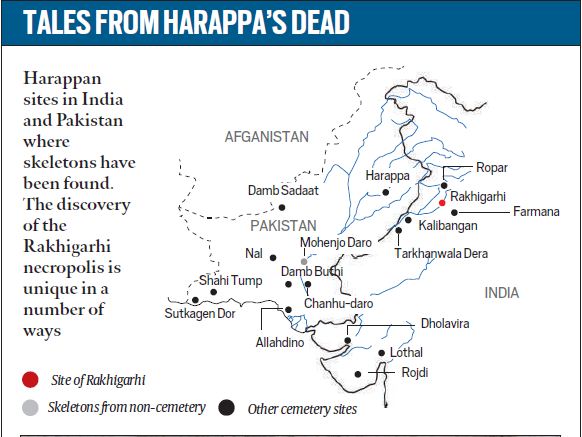Why in news?
Near-complete skeletal remains of a young male and female have recently been discovered at an archaeological site in Rakhigarhi village in Haryana.
What was the finding?
- Rakhigarhi was one of the most prominent sites of the Harappan civilisation.

- A team of Indian and South Korean researchers carried out excavations in Rakhigarhi between 2013 and 2016.
- The skeletal remains of the couple were discovered from a site where nine graves were unearthed in one trench.
- Except for the foot bones, the two skeletons have been found almost entirely intact.
- Of the 62 graves discovered in Rakhigarhi, only this one had more than one skeleton and of individuals of the opposite sex, together.
- The researchers believe the couple were buried at almost the same time, perhaps even together, following their deaths which could have occurred about 4,700 years ago.
What does the site reveal on marriage?
- Most archaeological recoveries show individuals were buried separately in Harappan times.
- Joint graves have been very rare, and almost none have been found containing a couple.
- The only joint burial of a couple discovered earlier has been from Lothal in Gujarat.
- But there, the skeletal remains of the male and female were found placed over one other, indicating that they may have been buried at the same place, but at different times.
- In addition, the female skeletal remains were found to have lesions or injury marks.
- This has made archaeologists to conclude that her death could have been the result of a social practice such as Sati.
- Remains of pots and stone-bead jewellery found close to the burial site of the couple point to the possibility of a ceremonial burial with rituals.
- These remains also suggest they belonged to a middle-class family.
- The Harappan people were generally known to strictly adhere to only legal relations.
- Thus, the fact that the couple were buried in the same pit together could be an indication of societal acceptance of their relationship.
- The researchers were inclined to believe that they could have been married.
- This which would in turn suggest the possibility that the institution of marriage originated in the Harappan civilisation.
What are the other findings regarding the graves?
- Broadly, three types of graves have been discovered at Harappan sites.
- Primary grave, the most common type, where archaeologists have found full-body remains of the person placed inside a pit.
- Secondary pits were those that contained partial remains of a few bones placed in the pit.
- In the third type, instead of skeletal remains there were just some accessories, presumably the belongings of the deceased person. (Perhaps the body could not be ever retrieved, due to deaths caused by wild animals or during wars.)
- Most of the graves at the Harappa sites have been that of men, with only 20% of graves are of women, while fewer than that of 1% are of children.
- However, excavations of cemeteries so far have found that graves of women were positioned in the centre of the cemetery, and surrounded with bangles, jewellery, and other ornaments.
- This could mean that the Harappan society gave a higher status to women.
Source: The Indian Express
